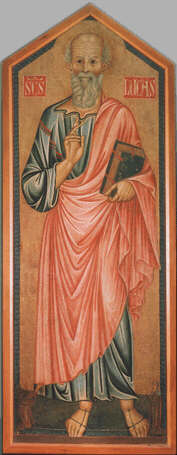10: Renaissance in the Visual Arts and Rome
Accounting for art

Example: Rome, Capella Chigi, Santa Maria del Popolo
Giotto di Bondone, 1256-1337, Ognissanti Madonna
work of art
- How was it made? By whom? original location? original use?
- Who paid for it? What was their relationship with the artist? With the location of the work?
- Style. What are the norms? Did the artist meet those norms? Change them?
producers: the artists
- Who are artists in sociological terms? How does this change?
- What kinds of education do they have?
Our example: Rome
- naturalism (painting)
- ancient models (architecture)
- linear perspective
Production of art
Kinds produced ca. 1400
- religious
- public art and architecture (ex: Palazzo Senatorio)
- private: palazzi, villas (15th c+)
Religious art. Who pays for it: mostly private funding
papacy? (only main basilicas)
buildings
chapels in churches
private religious art for home meditation
changes in worship affect art
- ex: mendicant orders
patronage relationships: “The Customer”
- Paying for a specific object
- Deliberate support of an individual’s career
shop as location of production
Changes in artistic style I: Drama and realism in painting
Italy ca 1250: several imported traditions, then innovation
- Byzantine
- French: “International Gothic” style
- Friars emotional response on part of viewer
- Ancient models: almost none before 1500 (Domus Aurea)
inspire admiration

Maddalena master: S. Luca, late 13th c (Uffizi)
Leon Battista Alberti 1404-72
- Padua education
- law degree (Bologna)
- 1431 Rome; cleric; interest in ancient ruins and buildings
- back to Florence (cathedral)
Filippo Brunelleschi (1377-1446)
First surviving paintings in perspective: Masaccio (1401-28), Masolino (1383 – c. 1447) Florence
Rome: SMM Altarpiece
council of Florence, Eugenius IV
Changes in artistic style II: Perspective in painting
— Alberti, Brunelleschi
quadrivium: add perspective/optics?
Piero della Francesca, Luca Pacioli
artists need education
Influence of humanists on subject matter

Botticelli, Calumny of Apelles
Architecture:
Discovery of Vitruvius On Architecture: 1st c BCE (prob. after 27)
- Petrarch; Poggio Bracciolini
- published: Rome, 1486
- ancient rules, ancient examples
- Architect as learned person (like Quintilian, Cicero)
Filarete door, St Peter’s
